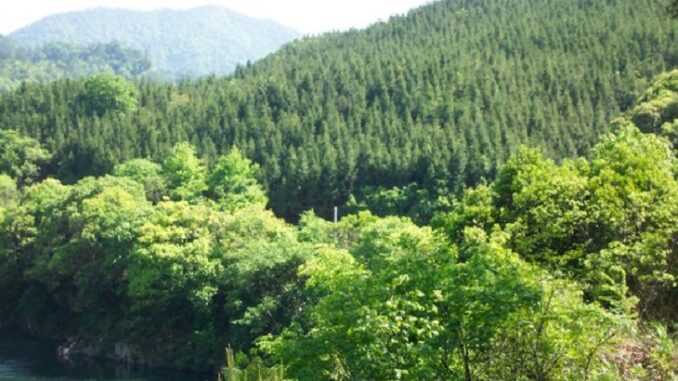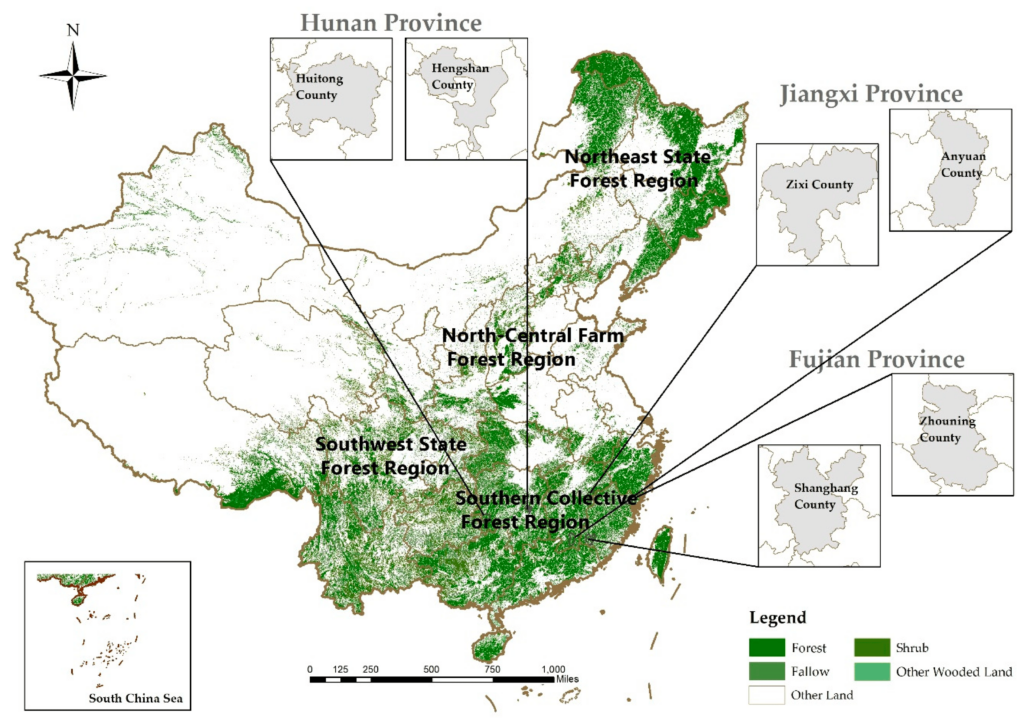
Why does China seem insatiable with trees?
In this article Beijing Channel looks at a piece of long-running Chinese policy – it’s decades-long quest to re-forest the country.
Before diving into the details, here’s some statistics to show how serious, and successful China has been about planting trees:
- In 1949, when the PRC was founded, 8.6% of China’s landmass was forested. In 2022, that figure stood at 24.02%, three times the level in 1949. The change was even more pronounced in the past 10 years. Between 2012 and 2022, China added 193,700 square kilometers of forest, approximately double the size of South Korea.
- According to a 2020 report by the Food and Agriculture Organization of the United Nations (FAO), China has annually increased its forest area by an average of 1.937 million hectares over the past 10 years, with a growth rate of 0.93%, surpassing other countries. Between 2010 and 2020, China, Australia, and India ranked as the top three countries globally regarding the average annual net increase in forest area.
Now let’s retrace China’s steps and see how exactly China’s been able to pull off this feat.
【1】 The Policies
When the PRC was founded in 1949, China’s natural environment was at a low point. Hundreds of years of population growth and war have depleted the country of trees, which have in turn led to a host of other environmental issues, such as land degradation in the middle and lower reaches of the Yellow River.
So from very early on, the Chinese government realized that the country needed more trees. In recognition of this need, China has formulated various policies and regulations to bolster afforestation initiatives.
On October 26, 1955, the Central School of the Communist Youth League of China decided to organize a youth afforestation conference in the provinces and autonomous regions of Shaanxi, Gansu, Shanxi, Inner Mongolia, and Henan (《关于召开陕西、甘肃、山西、内蒙古、河南五省(自治区)青年造林大会的决定》).
This marked the beginning of an unprecedented afforestation campaign led by the nation’s youth. From the autumn of 1955 to the spring of 1956, over 66.6 million young people actively participated in reforestation activities. They planted 5.46 million mu (equal to 363,600 hectares) of trees, amounting to a total of 2.2 billion trees.
In March 1956, Mao Zedong called on China to “green the motherland” and “realize the gardening of the earth”. China began a “12-year greening campaign” with the goal of “basically eliminating barren land and barren hills within 12 years, and planting trees according to specifications and greening in all possible places beside houses, villages, roadsides, waterfronts, and barren land and barren hills. “
Entering the 1970s, China gradually increased its financial, human, and logistical investment in forestry.
Since environmental issues led by deforestation were particularly severe in Northern China, the “three norths“, or the Northwest, the North, and Northeast were the focus of China’s tree planting campaigns.

In order to fundamentally solve the wind-sand disasters and water and soil erosion in the Three-North region, on November 25, 1978, the State Council approved the State Forestry Administration’s plan to build a large-scale shelter-belt in the Three-North key areas of wind-sand disasters and water and soil erosion. (《国务院批转国家林业总局关于在三北风沙危害和水土流失重点地区建设大型防护林的规划》)
The Three-North Shelterbelt Program construction project was officially launched. This is a large-scale artificial forestry ecological project in the three northern regions of China. The program involved 725 counties in 13 provinces in the Three-North region, with a total area of 4,358,000 square kilometers, accounting for 45% of China’s total land area.
While China has always stayed on the track to plant more trees, the purpose it served shifted through the years. In earlier years, trees were planted not solely to improve the environment, but more importantly for industrial and economic development. Mixed goals produced mixed results. Despite the overall effectiveness of afforestation efforts during this period, China’s forest cover and forest stock did not experience significant growth. This was primarily due to inefficiencies in tree planting campaigns, low survival rates of trees, as well as the presence of low-efficiency logging industries and indiscriminate logging practices.
Under the leadership of Deng Xiaoping, China’s tree-planting efforts entered a new stage. On February 23, 1979, the Fifth National People’s Congress (NPC) Standing Committee adopted the Forestry Law (For Trial Implementation) (《中华人民共和国森林法(试行)》), deciding that March 12 of each year is China’s Arbor Day.
The date was chosen to commemorate the death of Dr. Sun Yat-sen, a revolutionary who helped overthrow the Qing dynasty. Since the republic era, the Chinese government encouraged the public to plant trees on this day as an act of memorial. Later the PRC kept the tradition when it designated March 12 as the official tree-planting day.
On Arbor Day 1982, Deng took the lead in planting a tree on Beijing’s Yuquan Mountain, creating a tradition for Chinese leaders to personally participate in tree plantings each spring.
The 1980s saw more policy papers and legislation to promote tree planting.
On December 13, 1981, the Resolution on Nationwide Voluntary Tree-Planting Campaign (《关于开展全民义务植树运动的决议》) was discussed and adopted at the fourth session of the Fifth NPC. The tree-planting campaign began to be implemented as a law nationwide. It was no longer just an occasional activity but an obligation for the whole society to participate.
The Forest Law of the People’s Republic of China (《中华人民共和国森林法》) was adopted at the seventh meeting of the Standing Committee of the Sixth NPC on September 20, 1984, stipulating that the state shall protect, reasonably utilize and sustainably develop forest resources and meanwhile increase the penalties for illegal logging and deforestation. Forest resources are protected at the legal level.
In 2000, China further introduced the Regulation on the Implementation of the Forestry Law of the People’s Republic of China (《中华人民共和国森林法实施条例》) to provide further clarification of implementation rules regarding the scope of forest resource protection and management, legal responsibilities, and regulatory mechanisms.
In the 1990s, more ecologically friendly concepts were incorporated into environmental protection policies. In 1991, the State Council approved the National Desertification Control Project Plan for 1991-2000 (《1991—2000年全国治沙工程规划要点》), which was designed specifically to tackle desertification.
In 1998, China launched a pilot program aimed at better protecting the country’s natural forests, partially by increasing artificial and economic forests. In 1999, the Restoring Farmland to Forest project (‘Grain for Green’) was officially promoted and became a crucial platform for more tree planting.

According to the National Forestry and Grassland Administration, by the end of 2021, the central government had invested 551.5 billion yuan in returning farmland to forest, benefiting 41 million farmers and 158 million herdsmen.
The 2000s saw the coining of the phrase ecological civilization and its inclusion in top-level party documents, which created a new and powerful impetus for environmental protection efforts.
To cope with the increasingly serious desertification in China, on August 31, 2001, the Chinese government issued the Law of the People’s Republic of China on Desert Prevention and Transformation (《中华人民共和国防沙治沙法》), which stipulates the fundamental policies, principles, and tasks of desertification prevention and transformation, and defines the responsibilities and rights of governments and relevant departments at all levels. In 2005, China launched the “Greening China” campaign, which planned to plant 13 trillion trees covering an area of 35 million hectares within ten years.
Since the 18th CPC National Congress, the Chinese government has issued more detailed and scientific regulations related to tree planting.
In August 2014, the National Development and Reform Commission (NDRC) and the Ministry of Finance, State Forestry Administration (Now the State Forestry and Grassland Administration), Ministry of Agriculture, and Ministry of Land and Resources jointly issued the Circular on the General Plan for the New Round of Restoring Farmland to Forest and Grass (《关于新一轮退耕还林还草总体方案的通知》), aiming to promote the conservation and sustainable use of forest resources and improve the ecological environment.
In 2015, the CPC Central Committee and the State Council issued the Opinions of the CPC Central Committee and the State Council on Accelerating the Ecological Civilization Construction (《关于加强生态文明建设的意见》), which put forward the overall requirements, goals and basic principles for strengthening the ecological civilization construction, and emphasized the critical tasks of protecting the ecological environment and promoting green development.
In 2016, the “Thirteenth Five-Year Plan” for Forestry Development (《林业发展“十三五”规划》) was released, which clarified the general ideas, development goals, and main tasks for the development of national forestry and grassland industries in the next five years, emphasizing key tasks such as strengthening the protection and restoration of forest resources and expanding the scale of forestry industries.
In 2021, the NDRC and the Ministry of Natural Resources unveiled a plan outlining significant projects aimed at safeguarding and rejuvenating crucial ecosystems from 2021 to 2035 (《全国重要生态系统保护和修复重大工程总体规划(2021—2035年)》). This is the first comprehensive plan in the environmental protection and restoration field issued at the national level since the 19th Party Congress.
To complement the existing Desertification Prevention and Control Law (《中华人民共和国防沙治沙法》), the Chinese government officially published the Plan for National Desert Prevention and Control (《全国防沙治沙规划(2021-2030年)》) on December 22, 2022, which clarifies the general idea, development goals and main tasks of desertification prevention and control in the next 10 years, and proposed a series of specific measures such as promoting desert greening and carrying out ecological migration.
【2】Relevant local practices in China
China is a vast country, and whenever the Central gov’t issues a top-down directive, localities often translate the directive into more applicable measures for their specific region.
This section compiled some of the original yet diverse measures some of the localities took.
To combat desertification in NW China, local people invented a structure called straw checkerboard, which is basically straw embedded into the sand in a checkerboard pattern that proved to be a very cost-effective measure to stop sand encroachment. Within the checkerboards, the surface of the sand forms a hard crust over time which prevents the sand from moving.
In the South, people opted to plant something else rather than trees, bamboos to be exact. For example, in 2022, the Guangdong Forestry Bureau and ten other government agencies jointly issued the Implementation Opinions on Accelerating the Innovative Development of Bamboo Industry in Guangdong (《关于加快推进广东竹产业创新发展的实施意见》), which proposed to maintain and precisely cultivate bamboo forest resources.

In the Eastern Chun’an County of Zhejiang Province, locals fused tree planting with Chinese herbal medicine cultivation, making “forest + Chinese herbal medicine” an efficient ecological restoration industry, successfully developing the economy and improving people’s living standards while protecting the environment.
With the government’s active promotion, many companies are also involved in afforestation activities. For example, Alibaba Group launched the “Green Growth Program” to promote ecological protection and green development in China by planting seedlings and cultivating public forests.
Source: Beijing Channel, June 06, 2023. https://beijingchannel.substack.com/p/why-does-china-seem-insatiable-with
Author: Xinyi Zhang